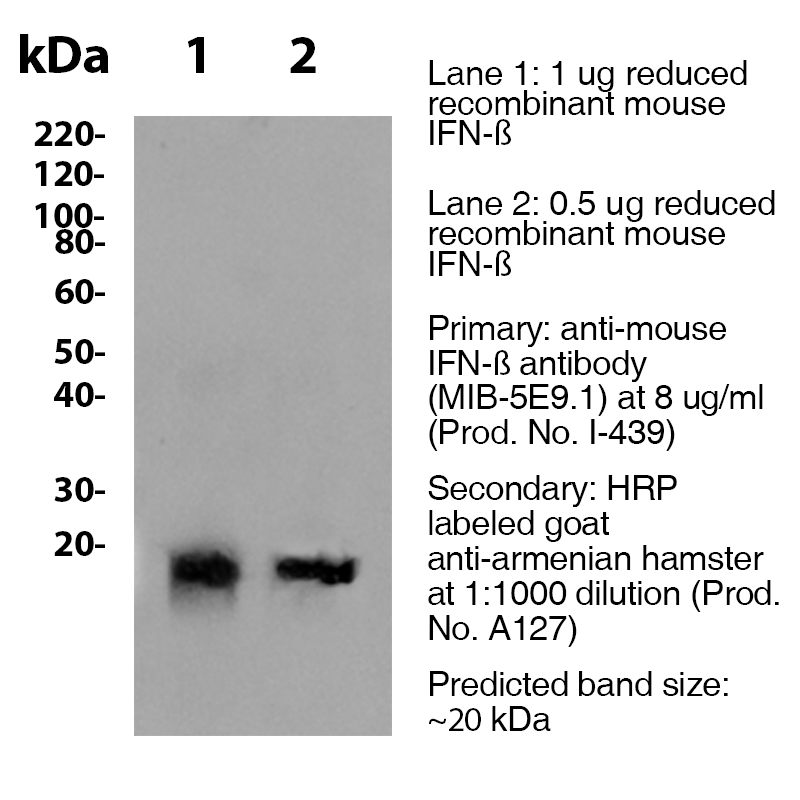Anti-Mouse IFNß [Clone MIB-5E9.1] — Purified in vivo GOLD™ Functional Grade
Anti-Mouse IFNß [Clone MIB-5E9.1] — Purified in vivo GOLD™ Functional Grade
Product No.: I-439
Clone MIB-5E9.1 Target IFNβ Formats AvailableView All Product Type Monoclonal Antibody Alternate Names Interferon-β, Fibroblast interferon, Type-1 interferon, acid-stable interferon, interferon beta Isotype IgG Applications in vivo , N , WB |
Data
Antibody DetailsProduct DetailsReactive Species Mouse Host Species Armenian Hamster Recommended Dilution Buffer Product Concentration ≥ 5.0 mg/ml Endotoxin Level < 1.0 EU/mg as determined by the LAL method Purity ≥95% monomer by analytical SEC ⋅ >95% by SDS Page Formulation This monoclonal antibody is aseptically packaged and formulated in 0.01 M phosphate buffered saline (150 mM NaCl) PBS pH 7.2 - 7.4 with no carrier protein, potassium, calcium or preservatives added. Due to inherent biochemical properties of antibodies, certain products may be prone to precipitation over time. Precipitation may be removed by aseptic centrifugation and/or filtration. Product Preparation Functional grade preclinical antibodies are manufactured in an animal free facility using in vitro cell culture techniques and are purified by a multi-step process including the use of protein A or G to assure extremely low levels of endotoxins, leachable protein A or aggregates. Storage and Handling Functional grade preclinical antibodies may be stored sterile as received at 2-8°C for up to one month. For longer term storage, aseptically aliquot in working volumes without diluting and store at ≤ -70°C. Avoid Repeated Freeze Thaw Cycles. Country of Origin USA Shipping Next Day 2-8°C RRIDAB_2737543 Applications and Recommended Usage? Quality Tested by Leinco WB The purified antibody is recommended for Western blotting. The suggested concentration for this MIB-5E9.1 antibody for use in western blotting is 1-10 μg/ml. Additional Applications Reported In Literature ? N This antibody is recommended for neutralization of mouse IFN-β bioactivity Each investigator should determine their own optimal working dilution for specific applications. See directions on lot specific datasheets, as information may periodically change. DescriptionDescriptionSpecificity Armenian Hamster Anti-Mouse IFNβ (Clone MIB-5E9.1) recognizes Mouse IFNβ. This monoclonal antibody was purified using multi-step affinity chromatography methods such as Protein A or G depending on the species and isotype. Background Interferons (IFN) consist of two classes. The type I IFN class consists of 20 highly similar IFN-α proteins and a single IFN-ß protein. The second class, type II IFN, consists of a single protein, IFN-γ. IFN-α and IFN-ß signal through the same cell surface receptor IFNAR1 and have a similar range of biological activities including antiviral and antiproliferative activity. The type I IFNs also influence activation, growth and differentiation of T cells, B cells, macrophages, NK cells and other cell types such as endothelial cells and fibroblasts. IFN-ß has recently proven to be beneficial in patients with multiple sclerosis and could also be a potential therapy for rheumatoid arthritis. It is unclear what cellular mechanisms are involved in IFN-ß’s therapeutic effects, but they may be caused by a restoration of balance between pro- and anti-inflammatory cytokines. Antigen Distribution Fibroblasts & epithelial cells Ligand/Receptor IFNα/βR (IFNAR-1, IFNAR-2) NCBI Gene Bank ID UniProt.org Research Area Apoptosis . Cell Biology . Cell Death . Signal Transduction . Tumor Suppressors Leinco Antibody AdvisorPowered by AI: AI is experimental and still learning how to provide the best assistance. It may occasionally generate incorrect or incomplete responses. Please do not rely solely on its recommendations when making purchasing decisions or designing experiments. Clone MIB-5E9.1 is an Armenian hamster monoclonal antibody widely used in vivo in mice to neutralize interferon-beta (IFN-β), primarily to study the role and mechanisms of type I interferon signaling in various disease and immunological models. Key in vivo applications include:
Supporting details:
In summary, the most common in vivo application of MIB-5E9.1 in mice is the neutralization of mouse IFN-β to investigate its function in models of infection, cancer, and autoimmunity. In the literature, the MIB-5E9.1 antibody, which targets mouse IFN-β, is often used alongside other cytokine and checkpoint antibodies. These include:
These antibodies are used in various applications, including neutralization assays, Western blotting, ELISA, and in vivo studies, to investigate immune responses and cytokine dynamics. There are no key scientific findings directly linked to the use of clone MIB-5E9.1 in the cited literature; instead, references focus primarily on the technical specifications, recommended uses, and detection capabilities of this antibody for mouse interferon beta (IFNβ). Key points from available sources:
In summary, clone MIB-5E9.1 is well-characterized as a research tool for mouse IFNβ studies, with its principal citation value lying in its technical application rather than in yielding unique scientific findings or biological insights. The dosing regimens for the clone MIB-5E9.1, an Armenian hamster anti-mouse IFN-β monoclonal antibody, can vary depending on the specific mouse model and the experimental objectives. However, detailed specific dosing regimens for different mouse models are not explicitly outlined in the available search results. Here are some general considerations for dosing antibodies in mouse models:
In summary, while specific dosing regimens for MIB-5E9.1 across different mouse models are not detailed in the search results, researchers generally optimize dosing based on the experimental goals and models used. It is important to consult peer-reviewed literature or specific product datasheets for guidance on using this antibody in experimental settings. References & CitationsTechnical ProtocolsCertificate of Analysis |
Related Products
Prod No. | Description |
|---|---|
S211 | |
R1364 | |
I-140 | |
F1175 | |
A132 |
Formats Available
Prod No. | Description |
|---|---|
I-440 | |
I-439 |
 Products are for research use only. Not for use in diagnostic or therapeutic procedures.
Products are for research use only. Not for use in diagnostic or therapeutic procedures.



